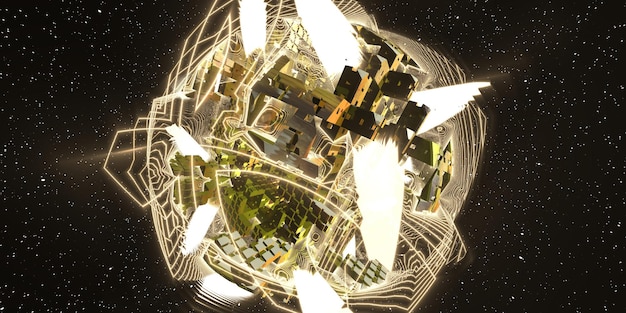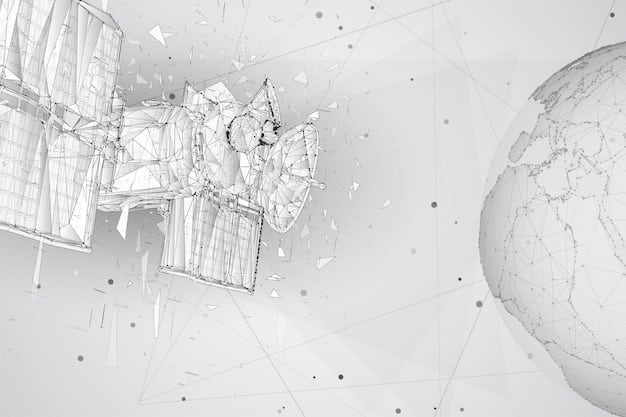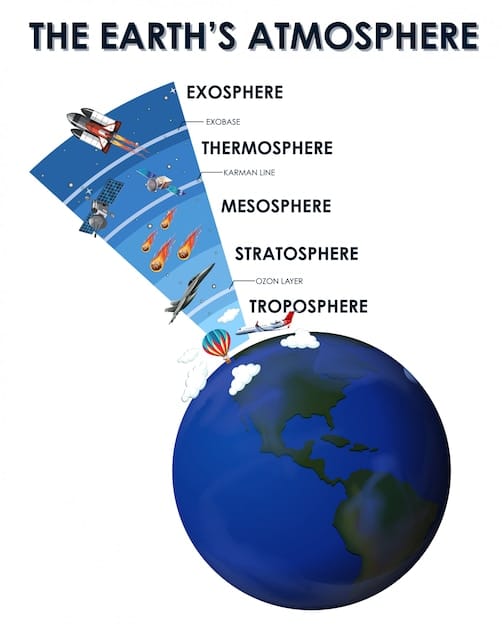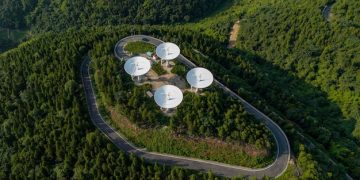Space Debris Removal: Cleaning Up Low Earth Orbit (LEO) Tech

The development of advanced technologies for space debris removal is crucial for safeguarding active satellites and future space missions by mitigating the escalating risks posed by orbital junk in Low Earth Orbit.
The burgeoning issue of space debris removal: what technologies are being developed to clean up Low Earth Orbit? This query resonates with increasing urgency as humanity’s footprint in space expands, creating an orbital junkyard that threatens critical infrastructure and future exploration. From defunct satellites to spent rocket stages and countless tiny fragments, this debris hurtles around Earth at immense speeds, posing a formidable collision risk. Addressing this challenge demands ingenious solutions, and the brightest minds across the globe are dedicated to pioneering technologies that can mitigate this growing threat.
The escalating threat of space debris in low earth orbit
Low Earth Orbit (LEO) has become an increasingly crowded domain, a vital thoroughfare for telecommunications, Earth observation, and scientific research satellites. However, this critical region is also where the vast majority of human-made space debris resides. Understanding the scale and nature of this threat is the first step towards appreciating the urgency of cleanup efforts.
The sheer volume of debris is staggering. Estimates suggest millions of pieces of artificial debris, ranging from microscopic flecks of paint to entire defunct satellites, are currently orbiting Earth. Each piece, regardless of size, poses a significant hazard due to the extreme velocities at which they travel. A collision at orbital speeds can release tremendous energy, creating even more debris, a phenomenon known as the Kessler Syndrome, which hypothesizes a cascade of collisions rendering LEO unusable.
Types of Orbital Debris
- Defunct Satellites: These are non-operational spacecraft that have reached the end of their mission life but haven’t been deorbited.
- Spent Rocket Stages: Sections of launch vehicles that detach after delivering their payload into orbit.
- Mission-Related Debris: Items like lens caps, tools, and protective coverings released during satellite deployments or crewed missions.
- Fragmentation Debris: The result of collisions, explosions, or controlled anti-satellite missile tests, producing a multitude of smaller, often untrackable pieces.
The impact of this debris is far-reaching. Active satellites, essential for modern life—from GPS navigation to weather forecasting—are constantly at risk. Even a tiny paint fleck can cause significant damage to spacecraft components, while larger objects can lead to catastrophic failures. Furthermore, the presence of debris complicates future space launches, demanding meticulous trajectory planning to avoid known objects and increasing the cost and risk of accessing space. The long-term sustainability of space utilization hinges on effective debris mitigation and removal strategies. This necessitates a proactive approach, combining international collaboration with technological innovation to safeguard this shared frontier.
Active debris removal mechanisms: The net and harpoon
Among the most discussed and actively developed technologies for space debris removal are capture mechanisms like the net and the harpoon. These methods aim to physically grapple or impale debris, bringing it under control for deorbiting. While seemingly straightforward, implementing these technologies in the harsh environment of space presents numerous engineering challenges.
The concept of using a net involves deploying a large, durable net from a “chaser” satellite, designed to envelop and capture the target debris. Once ensnared, the chaser satellite would then maneuver to pull the captured debris out of orbit, either by directly propelling it into Earth’s atmosphere for controlled burn-up or by guiding it to a specific disposal orbit. This method is particularly promising for capturing irregular or tumbling objects that are difficult to grasp with robotic arms. Challenges include ensuring the net effectively deploys and encapsulates the debris, preventing rebound, and managing the stability of both the chaser and the captured object.
Advantages and Challenges of Net Capture
- Versatility: Can capture a wide range of sizes and shapes, including irregular and tumbling objects.
- Non-Contact Initial Phase: Reduces the risk of further fragmentation during initial capture.
- Complex Dynamics: Managing the dynamics of a flexible net and captured object in microgravity is challenging.
- Deployment Reliability: Ensuring the net deploys correctly and without entanglement.
Conversely, the harpoon technology involves firing a tethered projectile into a large piece of debris. The harpoon penetrates the target, and once anchored, the debris can then be pulled towards the chaser spacecraft. This method is generally considered for larger, more robust debris items, such as defunct satellite bodies or rocket stages, where a more forceful and precise engagement is possible. The primary advantage lies in its ability to securely attach to the target. However, the risk of fragmentation upon impact, the need for precise targeting, and the forces exerted on both the harpoon and the chaser during penetration and reeling are critical considerations. Both net and harpoon technologies represent significant strides in active debris removal, but their real-world application requires rigorous testing and refinement to ensure mission success and prevent unintended consequences.

Robotic arms and grappling systems: Precision in debris handling
Just as in terrestrial operations, robotic arms offer a precise and controlled approach to manipulating objects in space. For space debris removal, these systems are evolving to handle the unique challenges of capturing unresponsive and potentially rotating targets. The principle involves a “chaser” satellite equipped with a multi-jointed robotic arm that can approach, identify, and precisely grasp a piece of debris.
One of the key advantages of robotic arm systems is their ability to provide controlled interaction. Unlike nets or harpoons, which involve dynamic capture, an arm allows for a more gentle and deliberate engagement, minimizing the risk of further fragmentation. This precision is vital, especially when dealing with complex or delicate debris. Once a piece of debris is secured, the robotic arm can maneuver it into a capture mechanism, such as a specialized containment bay, or maintain a firm hold while the chaser spacecraft initiates a deorbiting maneuver. The Canadian Space Agency’s Canadarm, a legacy system used on the Space Shuttle and International Space Station, has paved the way for advanced versions designed specifically for orbital servicing and debris removal.
Key considerations for robotic arm capture
- Target Stabilization: The ability to accurately track and counter the rotation of tumbling debris is paramount.
- Vibration Control: Minimizing vibrations during grasping to prevent unintended movement or damage to the chaser spacecraft.
- Force Feedback: Providing operators with a sense of “touch” in space to prevent damage to the target or the arm’s end-effector.
- Autonomous Operation: Developing systems that can autonomously identify, approach, and grapple debris, reducing reliance on real-time human control.
However, the challenges are considerable. The debris object may not have dedicated grappling points, requiring the arm to securely grasp irregular surfaces. Furthermore, the varying size, mass, and rotational dynamics of debris dictate highly adaptable and robust end-effectors. Robotic arms are often envisioned for larger, more predictable debris items, such as the upper stages of rockets or defunct satellites that still have some structural integrity. Their development is a testament to the growing sophistication of space robotics and their potential to play a critical role in maintaining a sustainable orbital environment.
Laser ablation and ion beam shepherds: Non-contact debris management
While physical capture methods offer direct removal, non-contact approaches such as laser ablation and ion beam shepherds present intriguing alternatives, particularly for smaller, untrackable debris or for gently nudging objects into desired trajectories without direct physical interaction. These technologies represent a departure from traditional mechanical solutions, focusing instead on imparting momentum to debris from a distance.
Laser ablation involves a ground-based or space-based laser firing pulses at a piece of space debris. The energy from the laser ablates (vaporizes) a tiny amount of material from the debris surface. This rapid vaporization creates a small plume of plasma, which, by Newton’s third law, generates a tiny thrust on the debris in the opposite direction. By repeatedly firing the laser, this cumulative thrust can gradually alter the debris’s orbit, eventually pushing it into a lower altitude where atmospheric drag will cause it to deorbit and burn up harmlessly. This method is particularly attractive for very small debris that is difficult or impossible to capture mechanically, as it avoids the risk of creating more fragments through impact.
Specifics of Non-Contact Methods
- Laser Ablation: Uses focused laser energy to vaporize surface material, creating a propulsive force to deorbit debris. Effective for smaller objects.
- Ion Beam Shepherd: Employs a beam of charged particles to transfer momentum to debris without physical contact. Ideal for gently guiding larger objects.
- Advantages: Reduced risk of fragmentation, can target multiple objects (especially laser abatement), avoids complex capture mechanisms.
- Challenges: Precision targeting, power requirements (for lasers), maintaining a stable beam, potential for secondary plasma creation.
The ion beam shepherd, on the other hand, utilizes a beam of highly energetic ions emitted from a “shepherd” spacecraft. When this ion beam strikes a piece of debris, it transfers momentum to it, effectively pushing it without making physical contact. This is similar to how a steady stream of water can push a floating object. Unlike laser ablation, which is more suited for accelerating atmospheric re-entry, the ion beam shepherd technique is envisioned for more precise orbital maneuvers, such as nudging a large defunct satellite into a graveyard orbit or adjusting its trajectory to avoid collision. Both laser ablation and ion beam shepherds offer the advantage of not requiring physical grappling, reducing the risk of further fragmentation, but they face technical hurdles related to power efficiency, beam stability, and the ability to impart sufficient momentum to large objects over extended periods.
Advanced propulsion and deorbiting strategies: The natural solution
Beyond active capture or remote manipulation, another critical avenue of space debris removal focuses on leveraging or augmenting natural forces to deorbit objects. This involves equipping satellites with advanced propulsion systems or deploying specialized devices that accelerate their atmospheric decay. The goal is to ensure that when a satellite reaches its end-of-life, it can be removed from orbit within a reasonable timeframe, typically set by international guidelines at 25 years.
One approach involves enhancing the deorbiting capabilities of satellites themselves. This can be achieved through small, highly efficient electric propulsion systems, such as ion thrusters or Hall effect thrusters, which can provide a steady, albeit low, thrust to gradually lower the satellite’s orbit. Another concept involves deploying drag sails or tethers after a mission concludes. These lightweight, often inflatable structures significantly increase the satellite’s surface area, thereby maximizing the atmospheric drag it experiences, even in the extremely thin upper layers of the atmosphere. This increased drag causes a faster decay of the orbit, leading to a more rapid re-entry and burn-up.
Propulsion and Drag Enhancement Techniques
- Electric Propulsion: Small, efficient thrusters for gradual deorbiting after mission completion.
- Drag Sails: Deployable membranes that increase atmospheric drag, accelerating deorbiting.
- Tethers: Long, conductive wires that can generate drag or even a propulsive force using Earth’s magnetic field.
- Challenges: Ensuring reliability of deployment mechanisms, managing satellite orientation for effective drag, long deorbiting times for some methods.
The concept of “graveyard orbits” for geostationary satellites also falls under deorbiting strategies, although it doesn’t remove debris from LEO. For LEO, controlled atmospheric re-entry is the preferred method to prevent the accumulation of debris. For larger objects, a controlled re-entry is crucial to ensure that any surviving fragments land in uninhabited areas, such as designated zones over the Pacific Ocean. The development of more robust and reliable deorbiting mechanisms, whether self-contained within the satellite or deployed externally, is paramount for sustainable space operations, moving from remediation to prevention as the primary strategy for managing the space environment. These technologies, while less dramatic than active capture, form the backbone of a long-term solution to the debris problem.
International collaboration and policy: A global challenge, a global solution
The problem of space debris is inherently global. Debris objects do not respect national borders; they orbit Earth, presenting a risk to all space-faring nations. Therefore, effective space debris removal and mitigation strategies necessitate unprecedented levels of international collaboration, policy development, and shared responsibility. No single nation possesses the resources or the authority to unilaterally solve this complex issue. This collaborative spirit manifests in various forms, from data sharing to developing common standards and even jointly funding research and development for cleanup technologies.
International organizations like the United Nations Committee on the Peaceful Uses of Outer Space (COPUOS) and the Inter-Agency Space Debris Coordination Committee (IADC) play crucial roles in fostering this cooperation. They facilitate the exchange of information on debris tracking, develop guidelines for debris mitigation (such as the 25-year deorbit rule for LEO satellites), and promote best practices for space operations. These guidelines, while not legally binding treaties, represent a strong international consensus and are widely adopted by national space agencies and commercial operators.
Key Pillars of International Cooperation
- Data Sharing: Sharing tracking data of debris objects to improve collision avoidance maneuvers.
- Policy Development: Establishing common guidelines and best practices for debris mitigation and removal.
- Research & Development: Collaborative efforts in designing and testing new debris removal technologies.
- Capacity Building: Assisting emerging space nations in adopting sustainable space practices.
Beyond governmental bodies, a growing number of private companies and academic institutions are also engaging in international partnerships to tackle the debris problem. These collaborations often focus on specific technological solutions, pooling expertise and resources to accelerate development and reduce costs. The discussions extend to legal frameworks, addressing questions of liability for debris and the ownership of removed objects. The legal and ethical complexities of active debris removal are as significant as the technical ones, demanding careful consideration to avoid unintended international disputes. Ultimately, the future of space hinges on a shared commitment to its long-term sustainability, an objective that can only be achieved through robust international cooperation and a unified approach to a problem that affects us all.

Economic and environmental considerations: The cost of a cluttered orbit
The challenge of space debris is not merely an engineering or security concern; it carries significant economic and environmental implications. The costs associated with a cluttered Low Earth Orbit are multifaceted, ranging from the direct expenses of collision avoidance and potential satellite replacement to broader impacts on future space industry growth and even the symbolic loss of a pristine celestial environment. Understanding these considerations is vital for justifying the substantial investment required for debris removal initiatives.
Economically, the presence of debris directly impacts satellite operators. Each active satellite must undergo periodic collision avoidance maneuvers, which consume precious fuel, shorten operational lifespans, and require substantial planning resources. The risk of losing a multi-million-dollar satellite to a debris collision is a constant worry, driving up insurance premiums and potentially limiting investment in new orbital ventures. Furthermore, a growing debris population increases the cost and complexity of launching new missions. Each launch window must be meticulously calculated to avoid known debris, adding to mission planning time and fuel consumption. The long-term economic consequence of a “Kessler Syndrome” scenario, where parts of LEO become too dangerous to operate in, could be catastrophic for vital industries reliant on space-based services.
Impacts of Space Debris
- Increased Operational Costs: For satellite operators due to fuel consumption for avoidance maneuvers and higher insurance premiums.
- Risk to Space Infrastructure: Potential loss of critical satellites, impacting services like GPS, weather forecasting, and communications.
- Hindrance to Future Missions: Complicates launch windows and trajectory planning, increasing risk and cost.
- Environmental Degradation: Contamination of the space environment, making it less accessible and sustainable for future generations.
Environmentally, space is often perceived as an infinite void, yet LEO is a finite resource, much like Earth’s atmosphere or oceans. The accumulation of debris represents a form of pollution that degrades this unique environment. It not only poses a physical threat but also obscures astronomical observations and contributes to light pollution, affecting the view of the night sky from Earth. While space debris does not have the immediate and tangible environmental impact of terrestrial pollution, its long-term consequences for space sustainability are profound. The development of debris removal technologies, therefore, should not be viewed solely as a technical challenge but as a critical investment in preserving a vital global commons for exploration, scientific discovery, and human prosperity for generations to come. The economic incentives and environmental imperative are powerful drivers behind the accelerating efforts to clean up our orbital neighborhood.
| Key Aspect | Brief Description |
|---|---|
| 🛰️ Escalating Threat | Millions of debris pieces in LEO threaten active satellites and future missions due to high velocities. |
| 🎣 Capture Tech | Nets and harpoons aim to physically capture debris for deorbiting, offering direct removal but posing engineering trials. |
| ⚡ Non-Contact Methods | Laser ablation and ion beam shepherds use momentum transfer to deorbit or modify debris paths without physical touch. |
| 🤝 Global Efforts | International collaboration and policy are crucial for tackling a global problem and ensuring sustainable space use. |
Frequently asked questions about space debris removal
▼
Space debris refers to non-functional, human-made objects orbiting Earth, ranging from defunct satellites to tiny paint flecks. It’s a problem because these objects travel at thousands of miles per hour, posing a significant collision risk to active satellites and future spacecraft, potentially disrupting vital services like GPS and weather monitoring, and making space access more perilous.
▼
Several technologies are under development. These include physical capture methods like nets and harpoons to ensnare or impale debris, robotic arms for precise grappling, and non-contact approaches such as laser ablation to vaporize surface material for thrust, and ion beam shepherds that push debris using a beam of charged particles. Each method targets different types and sizes of debris.
▼
No, it’s not currently feasible to remove all space debris, especially the millions of tiny, untrackable pieces. The focus is primarily on removing larger, high-risk objects that can cause cascading collisions (Kessler Syndrome), and on implementing mitigation measures for future missions to prevent the creation of new debris, ensuring the long-term sustainability of orbital environments.
▼
International collaboration is crucial because space debris is a global issue, not limited by national borders. Organizations like the UN and IADC facilitate data sharing, develop common guidelines for mitigation, and promote international partnerships for research and development of removal technologies. This ensures a unified approach to a shared problem, fostering sustainable and safe space operations for all.
▼
The Kessler Syndrome describes a hypothetical scenario where the density of objects in Low Earth Orbit becomes so high that collisions between objects cause a cascade of new debris, eventually rendering space unusable. Debris removal systems aim to prevent this by actively deorbiting larger, significant pieces of space junk that pose the highest collision risk, thus reducing the overall density and preventing catastrophic chain reactions.
Conclusion
The endeavor to clean up Low Earth Orbit is a monumental challenge, yet the advancements in space debris removal technologies demonstrate a compelling resolve to protect one of humanity’s most vital frontiers. From the precision of robotic arms and the direct engagement of nets and harpoons to the innovative touch of laser ablation and ion beam shepherds, a diverse arsenal of solutions is emerging. Coupled with robust international cooperation and a growing awareness of the economic and environmental imperatives, these technological developments offer a tangible path towards a more sustainable orbital environment. While the scale of the problem is vast, the ongoing innovation and collaborative spirit underscore a collective commitment to ensuring that space remains accessible and safe for future generations, transforming the orbital junkyard back into a launchpad for discovery.





